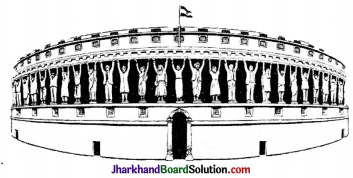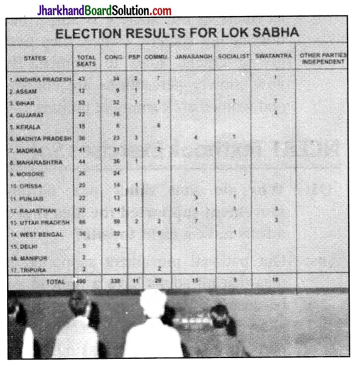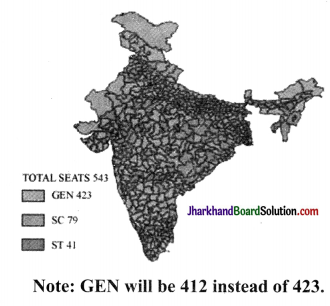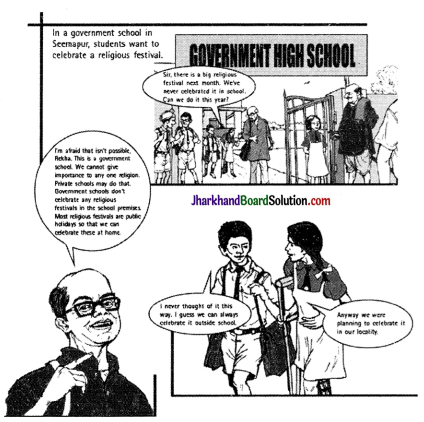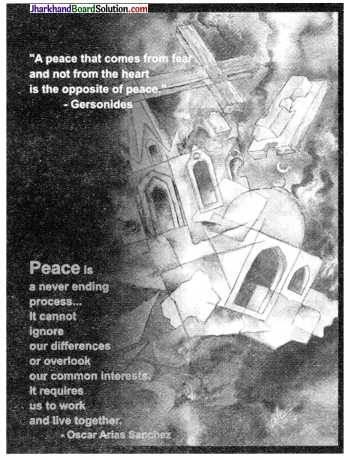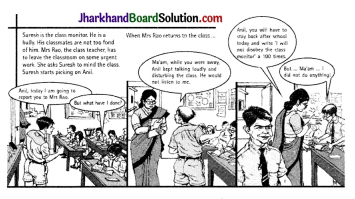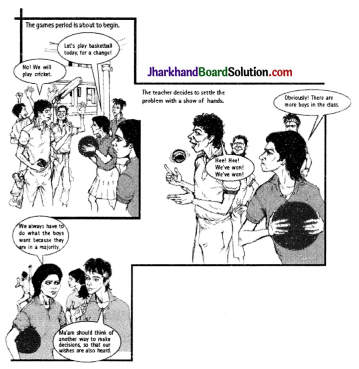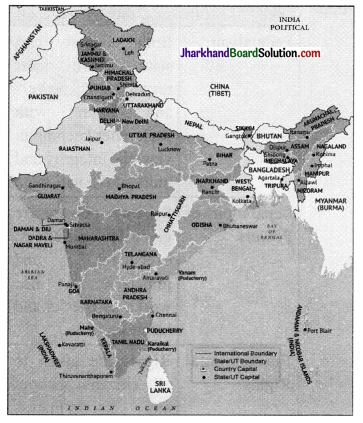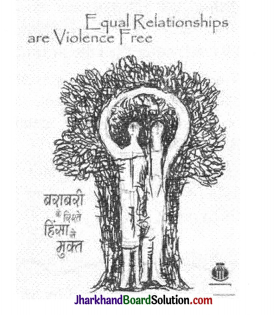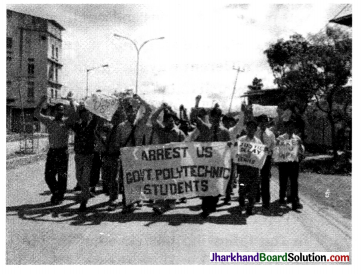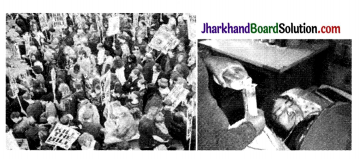JAC Board Class 8th Social Science Solutions Civics Chapter 7 Understanding Marginalisation
JAC Class 8th Civics Understanding Marginalisation InText Questions and Answers
Page 83
Question 1.
Explain at least three different reasons why groups may be marginalised.
Answer:
- Three different reasons for groups may be marginalized are as follows:
- They are poor.
- They speak different languages.
- They follow different customs and traditions.
Question 2.
Why was Dadu forced to leave his village in Odisha?
Answer:
The company wallahs took Dadu’s land for mining iron ore there. For this reason, Dadu was forced to leave his village in Odisha.
Question 3.
In your own city or village, who would you think are the marginalised groups? Discuss.
Answer:
Students need to do it on their own.

Question 4.
Can you name some Adivasi communities that live in your state? Answer: Students need to do it on their own. (Hint: Jharkhand: santhalis are there, etc).
Question 5.
What languages do they speak?
Answer:
Students need to do it on their own. (Hint: Santhals speak santhali in Jharkhand)
Question 6.
Do they live close to the forest?
Answer:
Yes, they live close to the forest.
Question 7.
Do they migrate to other regions looking for work?
Answer:
Yes, they migrate to other regions looking for work.
Question 8.
What metals are important in present-day India? Why? Where do they come from? Are there Adivasi populations there?
Answer:
The metals which are important in present day India are copper, iron, aluminum, manganese. They are important because they are mostly used in household works, industries. Iron, aluminum, copper are mainly found in Odisha, Chhattisgarh, Jharkhand. Manganese mainly found in Odisha, Jharkhand, Maharashtra, Madhya Pradesh. Yes, there are Adivasi populations present.

Question 9.
List five products that you use at home that come from the forest.
Answer:
Five products that we use at home which come from forest are:
Question 10.
By whom were the following demands being made on forest land?
- timber for construction of houses and railways
- forest land for mining
- forest land for agriculture by non- tribal people
- reserved by government as wildlife parks
In what ways would this affect tribal people?
Answer:
The British government made those demands. This would affect the establishment of the tribal people. They would not get the work easily as they would be displaced to other places.
Question 11.
What do you think this poem is trying to convey?
Come Mini, let’s go to Assam
Our country has so much suffering
The country of Assam, oh Mini Has tea gardens full of greenery…
The Sardar says work, work
The Babu says catch and bring them in
The Saheb says I’ll take off the skin of your back
Hey Jaduram, you deceived us by sending us to Assam.
Answer:
The poem is trying to convey the hopes of the migrants and reality of hardship they faced.
Page 87
In your opinion, why is it important that Adivasis should have a say in how their forests and forest lands are used?
Answer:
It is important that Adivasis should have a say in how their forests and forest lands are used because government’s decision on these crucial matters affect their lives and livelihood directly.
Page 88
Why do we need safeguards for minorities?
Answer:
We need to safeguard for minorities in order to protect them from any discriminations done by majorities.
Question 14.
I. Access to Basic Amenities, 20082009
| Religious Community | Pucca House | Electricity | Tap N Water |
| Hindu | 65.4 | 75.2 | 43.7 |
| Muslim | 63.8 | 67.5 | 35.8 |
| Christian | 69.3 | 86.2 | 48.0 |
| JSikh | 91.3 | 96.0 | 49.3 |
Which of these communities have the most and the least access to basic amenities?
Answer:
The communities which have the most and the least access to basic amenities are Sikh and Muslim.
Page 89
Question 15.
II. Literacy Rate by Religion, 2011 (percentages)
| All | Hindus | Muslims | Christians | Sikhs | Buddhists | Jains |
| 74 | 63 | 57 | 74 | 67 | 71 | 86 |
Which of these communities have the highest and the lowest literacy rate?
Answer:
The communities which have the highest and the lowest literacy rate are Jains and Muslims.
Question 16.
III. Public Employment of Muslims (percentages)
| Population | IAS | IPS | 1FS | Central Public | State | PSU Banks & RBI |
| Sector Unit (PSU) |
| 13.5 | 3 | 4 | 1.8 | 3.3 | 10.8 | 2.2 |
What do these figures convey?
Answer:
It conveys that they do not have equal representation in public employment.
Question 17.
Read the data related to schooling provided by the Sachar Committee Report:
25 per cent of Muslim children in the 6-14 years age group have either never been enrolled in school or have dropped out. This percentage is much higher than that of any other socio-religious community (page 58). Do you think special measures are required to address this situation?
Answer:
Yes, I think special measures are required to address this situation.

Page 90
Question 18.
live in a Muslim-dominated area. Some days back during Ramzan there was some disturbance that started taking a communal outlook. My b rother and 1 had gone for an Iftar party in theneighbourhood and were dressed in traditional clothes, that was sherwani and salwar-kameez respectively.
On returning home, my brother and I were asked to change our clothes to jeans and T-shirt. Now when eveiything is fine l wonder what was the reason that we were asked to change our clothes and why 1 didn’t find it odd. Were our clothes giving away our identity and is that identity linked to all kinds of fears and discrimination? The above essay has been written by a child around your age. What do you think she is trying to convey?
Answer:
In societies, people are hiding their identity to avoid tensions. Some traditional dresses signify particular communities. Such dresses become their identity and create communal tension sometimes. Hence, they can be targeted by the opposing groups.
JAC Class 8th Civics Understanding Marginalisation Textbook Questions and Answers
Question 1.
Write in your own words two or more sentences of what you understand by the word ‘marginalisation’.
Answer:
The process of being confined to a lower social standing is called as marginalisation. People are being denied of their fundamental rights that results in lowering their social and economic status. This situation occurs when a particular social group is forced to live on the edges rather than in the conventional society.
Question 2.
List two reasons why Adivasis are becoming increasingly marginalised.
Answer:
Adivasis are being increasingly marginalised for the following two reasons:
- Changes in forest laws disposes the Adivasis from their natural territory and livelihood due to which they turned into marginal and powerless communities.
- People consider Adivasis as exotic, primitive and backward communities that has led to their marginalisation.
Question 3.
Write one reason why you think the Constitution’s safeguards to protect minority communities are very important?
Answer:
The Constitution’s safeguards to protect minority communities are necessary to protect the minority communities because they are usually dominated by the maj ority and becoming marginalised. It focuses on protecting India’s cultural diversity and promoting equality as well as justice.
Question 4.
Re-read the section on Minorities and Marginalisation. What do you understand by the term minority?
Answer:
A community that is numerically small in relation to the rest of the population in terms of race, religion, language or political persuasion is known as minority.

Question 5.
You are participating in a debate where you have to provide reasons to support the following statement: ’Muslims are a marginalised community’. Using the data provided in this chapter, list two reasons that you would give.
Answer:
Two reasons are as follows:
- The literacy rate of Muslim population in India is only 57% which is the lowest compared to others.
- They lag behind the other communities even in access to the basic communities.
Question 6.
Imagine that you are watching the Republic Day parade on TV with a friend and she remarks, “Look at these tribals. They look so exotic. And they seem to be dancing all the time”. List three things that you would tell her about the lives of Adivasis in India.
Answer:
Three things that tells about the lives of Adivasis in India are as follows:
- Adivasis were hunters and gatherers and lived like nomads. They practised both shifting agriculture as well as cultivated at a single place.
- Adivasis have a deep knowledge of forests which made them indispensable and crucial to the rulers of various empires during the pre-colonial period in India.
- Adivasis have their own languages which have influenced the formation of Indian languages.
Question 7.
In the storyboard you read about how Helen hopes to make a movie on the Adivasi story. Can you help her by developing a short story on Adivasis?
Answer:
Student needs to do it on their own.
Question 8.
Would you agree with the statement that economic marginalisation and social marginalisation are interlinked? Why?
Answer:
Yes, economic marginalisation and social marginalisation are interlinked because of the following reasons:
(i) Social marginalisation is based on religion, culture, tradition, etc. Marginalised sections do not get proper access to anything such as jobs, education and health facilities due to which they are unable to become financially stable. This creates economic marginalisation.
(ii) When there is no economic development, the minorities do not develop socially. They remain backward. And hence, they become socially marginalised.
JAC Class 8th Civics Understanding Marginalisation Important Questions and Answers
Multiple Choice Questions
Question 1.
Adivasis are generally portrayed in:
(a) royal dress and crown.
(b) colourful costumes and headgear.
(c) black and white dresses.
(d) None of the above
Answer:
(b) colourful costumes and headgear.

Question 2.
Adivasis slowly and steadily began to migrate because:
(a) of economic changes and forest policies, they lost their access to forest.
(b) they got free admission in schools and colleges.
(c) of economic changes and forest policies, they got new houses in city area.
(d) all of these
Answer:
(a) of economic changes and forest policies, they lost their access to forest.
Question 3.
Adivasi means:
(a) the original inhabitants.
(b) people who live in rural areas.
(c) people who live in deserts.
(d) none of these
Answer:
(a) the original inhabitants.
Question 4:
…….. state in India is like home to more than 60 different tribal groups?
(a) Rajasthan
(b) Andhra Pradesh
(c) Mizoram
(d) Odisha
Answer:
(d) Odisha
Question 5:
During the nineteenth century, substantial numbers of Adivasis converted to……which has emerged as a very important religion in modern Adivasi history.
(a) Buddhist
(b) Vaishnav
(c) Christianity
(d) Jainism
Answer:
(c) Christianity
Question 6.
One of the Adivasi languages is ……..
(a) Bengali
(b) Santhali
(c) Kannad
(d) All of these
Answer:
(b) Santhali

Question 7.
Big empires heavily depended on Adivasis for the important access to forest resources, they were
(a) metal ores
(b) medicinal herbs
(c) animal products
(d) All of these
Answer:
(d) All of these
Question 8.
Adivasis migrated to cities in search of work. But eventually this happened to them:
(a) Many tribal children are malnourished.
(b) They get caught in a cycle of poverty and deprivation.
(c) They have no access to education.
(d) All of these
Answer:
(d) All of these
Question 9.
Tribals are referred to as………
(a) Untouchables
(b) Adivasis
(c) Dalits
(d) None of these
Answer:
(b) Adivasis
Question 10:
In…… state we won’t find Adivasis.
(a) Jharkhand
(b) Gujarat
(c) Kerala
(d) Odisha
Answer:
(c) Kerala
Very Short Answer Type Questions
Question 1.
Who are the marginalised groups in India?
Answer:
Some of the marginalised groups of India are the Adivasis, the Muslims and the Dalits.
Question 2.
What are the outcomes of marginalisation?
Answer:
The outcome of marginalisation results in having a low social status and not having equal access to education and other resources.
Question 3. Name the person who headed committee set up by the government to examine the social, economic, and educational status of Muslim community in India.
Answer:
Justice Rajindar Sachar headed committee set up by the government to examine the social, economic, and educational status of Muslim community in India.

Question 4.
How are Adivasis represented today?
Answer:
Adivasis are invariably represented in very stereotypical ways such as in colourful costumes, headgear and through their dancing. Often Adivasis are blamed for their lack of advancement as they are believed to be resistant to change or new ideas.
Question 5.
From which state the Adivasis moved in large numbers to various plantations in India and world?
Answer:
From Jharkhand and nearby places, the Adivasis moved in large numbers to vatious plantations in India and world.
Question 6.
What is the population of Adivasis in Assam in present day?
Answer:
The population of Adivasis in Assam in present day is around 70 lakh.

Question 7.
Where is Niyamgiri Hill located?
Which Adivasi community inhabits the place?
Answer:
Niyamgiri Hill is located in Kalahandi district of Odisha. The Adivasi community which inhabited the place is Dongarria Konds.
Question 8.
Why the Adivasi community have resisted the proposed development whose case is pending in the Supreme Court?
Answer:
The Adivasi community have resisted the proposed development whose case is pending in the Supreme Court because a major aluminium company was planning to set up a mine and a refinery which will displace the Adivasis.
Question 9.
How many plant species Adivasis used?
Answer:
Around 10,000 plant species Adivasis used.
Question 10.
According to the Report, the average years of schooling for which community children between what ages is much lower than that of other socio-religious communities?
Answer:
According to the Report, the average years of schooling for Muslim community children between the ages of 7-16 is much lower than that of other socio-religious communities.
Short Answer Type Questions
Question 1.
What was the conclusion reached by the Justice Rajindar Sachar Committee?
Answer:
The committee which was headed by Justice Rajinder Sachar came to the conclusion that on a range of social, economic and educational indicators the situation of the Muslim community is comparable to that of other marginalised communities like Scheduled Castes and Scheduled Tribes.
Question 2.
Why groups may be marginalised?
Answer:
Group’s marginalisation can be because they speak a different language, follow different customs or belong to a different religious group from the majority community. They may also feel marginalised because they are poor, considered to be of low social status and viewed as being less human than others.

Question 3.
How can we tackle Marginalisation?
Answer:
Marginalisation is a complex phenomenon which requires a variety of strategies, measures and safeguards to redress this situation. All of us have a stake in protecting the rights defined in the Constitution and the laws and policies framed to realize these rights. Without these, we will never be able to protect the diversity that makes our country unique nor realize the State’s commitment to promote equality for all.
Question 4.
How marginalisation affect the community?
Answer:
Sometimes, marginalised groups are viewed with bitterness, antagonism and fear. This sense of difference and exclusion leads to communities not having access to resources and opportunities and in their inability to assert their rights. They experience a sense of disadvantage and powerlessness and more powerful and dominant sections of society who own land are wealthy better educated and politically powerful.
Question 5.
Write a brief about the plant species used by the Adivasis.
Answer:
Adivasis use around 10,000 plant species in which approximately 8,000 species are used for medicinal purposes, 325 are used as pesticides, 425 as gums, resins and dyes, 550 as fibres; 3,500 are edible. They have vast knowledge about the plant species. This got wiped out as they lost their rights over the forest land.

Question 6.
What do you mean by Scheduled Tribes? Write in brief.
Answer:
Adivasi are also called as Scheduled Tribes. Indian Government use this term in official documents. When the government formulates any policy or programme for Scheduled Tribes then all the designated tribes are entitled for it.
Long Answer Type Questions
Question 1.
Discuss the hardships faced by the Adivasis?
Answer:
Hardships and deprivation faced by the Adivasis were as follows:
- Forest lands have been cleared for timber and to get land for agriculture and industry.
- Adivasis have also lived in areas that are rich in minerals and ores and other natural resources. These are taken over for mining and other large industrial projects.
- Dams that have been built in independent India has taken large tracts of their lands.
- In the north-east, their lands remain highly militarised and war-tom.
- There are areas where tribals originally lived but were evicted from there to build sanctuaries and parks. India has 54 national parks and 372 wildlife sanctuaries.
- Losing their lands and access to the forest means that tribals lose their main sources of livelihood and food.
- Adivasis have migrated to cities in search of work where they are employed for very low wages in local industries or at building or construction sites.
- They got caught in a cycle of poverty, deprivation and marginalisation.
Question 2.
Write a brief note on Adivasis.
Answer:
Adivasis, the term means original inhabitants. The communities who lived and often continue to live in close association with forests. Around 8 per cent of India’s population is Adivasi and many of India’s most important mining and industrial centres are located in Adivasi areas such as Jamshedpur, Rourkela, Bokaro and Bhilai among others. Adivasis are not a homogeneous population. There are over 500 different Adivasi groups in India. A state like Orissa is home to more than 60 different tribal groups.
Adivasis practise a range of tribal religions that are different from Islam, Hinduism and Christianity. These often involve the worship of ancestors, village and nature spirits. During the nineteenth century, substantial numbers of Adivasis converted to Christianity, which has emerged as a very important religion in modem Adivasi history. Adivasis have their own languages, which have often deeply influenced the formation of ‘mainstream’ Indian languages, like Bengali.
![]()
![]()
